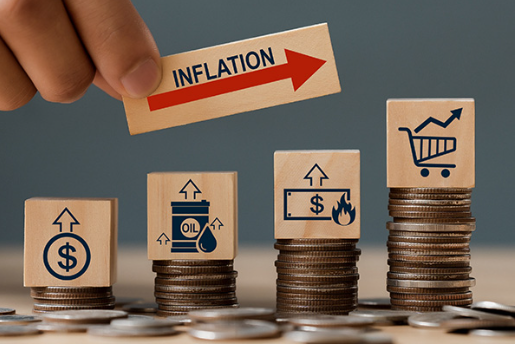The Impact of Inflation on Long-Term Savings and Investments
The Impact of Inflation on Long-Term Savings and Investments
Inflation erodes the purchasing power of your savings. Even if your savings account yields an interest rate higher than inflation, your money’s buying power will still decline with time The Impact of Inflation on Long-Term Savings and Investments.
It’s crucial to understand inflation and to adjust your savings and investment strategies accordingly. The following six tips can help you protect your money from inflation’s damaging effects: 1. Understand real interest rates.
Understanding Inflation Dynamics

The impact of inflation on savings and investments can be significant. Inflation erodes the purchasing power of currency over time, meaning that with the same amount of money you can purchase fewer goods and services. This is why understanding the dynamics of inflation is so important.
Inflation tends to increase when demand outpaces supply. This can be caused by factors such as high raw material prices, supply chain disruptions and geopolitical events. Inflation also tends to be more volatile in agricultural commodities and energy than in other sectors.
A key factor that drives the inflation environment is commodity prices and global demand. The current inflation environment is driven by a combination of easy monetary policy and pent-up demand from consumers. This has resulted in a rapid recovery of aggregate demand outpacing supply, particularly in goods sectors impacted by pandemic-related disruptions.
Erosion of Purchasing Power Over Time
Inflation can slowly erode the purchasing power of savings and investments over time. This can have a big impact on long-term savings goals, such as retirement, education, or buying a home. With every rise in prices, you’ll need a bigger and bigger chunk of your income to buy the same amount of goods.
The erosion of purchasing power caused by inflation is a major factor contributing to income inequality, as people with low incomes tend to spend more of their wages on essential goods like food and energy. These people also have less access to assets that appreciate in value during inflationary periods, such as stocks and real estate.
Inflation can also affect the purchasing power of investment returns, especially for investments with a fixed annual return, such as savings accounts or bank certificates of deposit. Investing in assets that historically offer returns higher than the rate of inflation can help offset the effects of inflation on your wealth. The key is to be prepared for rising costs by adjusting your budgeting and financial planning strategies.
Long-Term Effects on Savings Goals
Inflation erodes the purchasing power of money over time, and it can have serious consequences for people saving for retirement or other long-term goals. However, there are ways to protect your savings from inflation, and investing is one way to do it.
Investing in assets that can increase their value over time, such as stocks or bonds, can help you overcome inflation’s impact on your wealth. Inflation is often caused by changes in supply and demand for goods and services, but it can also be due to other factors. For example, a winter frost may cause a shortage of oranges, leading to higher prices for the fruit.
Inflation can also eat away at the real returns you earn on savings accounts and other low-risk investments, such as certificates of deposit or treasury bonds. To combat this, it’s important to diversify your investment portfolio and consider Treasury Inflation-Protected Securities (TIPS), which offer principal that adjusts with inflation. It’s also important to take inflation into account when setting financial goals, and a financial advisor can help you create an appropriate savings strategy for your unique situation.
Strategies to Combat Inflation’s Impact
Inflation may be unavoidable, but there are a number of strategies that can help mitigate its impact on savings and investment goals. These include diversifying the investment portfolio, investing in inflation-linked assets and taking steps to prepare for inflation.
The most obvious way to combat inflation is through investing in diversified assets. Stocks can provide a return that exceeds inflation over the long term, providing a powerful hedge against rising prices. However, stocks tend to perform less well in high inflation environments because stock prices are based on investor expectations and often do not reflect actual economic growth.
A diversified portfolio can also include other asset classes, such as real estate and commodities, to reduce exposure to inflation. Additionally, investments such as Treasury Inflation-Protected Securities (TIPS) are designed to protect against inflation by adjusting the principal value of the bond when it matures.
In addition, it is important to review short-term and long-term savings goals on a regular basis. This will allow you to monitor how well you are tracking toward your goals and make necessary adjustments.
Diversification of Investment Portfolio
While inflation is unpredictable, there are ways to protect your savings from its impact. If you want to keep your money safe, a certificate of deposit or a savings account at a bank or credit union is generally considered the best option because they don’t fluctuate with the economy. Those who prefer to invest their savings may be interested in a money market or stock index account, which vary in investments and track the economy without needing hands-on attention. Investors seeking more potential returns can consider adding Treasury Inflation-Protected Securities (TIPS) to their portfolios, which adjust their principal value in response to inflation. Those who want to diversify their exposure can also look for sector funds, which invest in different sectors of the economy.
Several investment classes have historically performed well during inflationary environments. These include commodities, real estate and Treasury inflation-indexed bonds. These investments tend to increase in value when the cost of goods and services rise, as they help to offset rising inflation. Changing your investment portfolio during high inflation can lead to a larger risk exposure because you could over-weight certain asset classes.
Utilizing Inflation-Linked Financial Instruments
Inflation can have a profound impact on your savings and investments. If you hold a significant amount of cash or low-interest savings accounts, the money will buy less and less with each passing year. This can make it difficult to reach long-term goals like buying a home or paying for college tuition.
However, there are ways to combat inflation by diversifying your investment portfolio and investing wisely. One strategy is to invest in assets that have historically outpaced inflation, such as stocks and real estate.
Another option is to invest in inflation-linked bonds, which adjust their principal value based on the country’s official rate of inflation. Inflation-linked bonds are issued by governments and are available to investors through banks and brokerages. The US government offers a bond known as Treasury Inflation Protected Securities (TIPS), and other countries have their own versions of these instruments.
However, the income from these instruments may not be taxed as a normal interest payment, which can reduce their overall return. Investors should consider the tax treatment of inflation-linked bonds before investing in them.
Adjusting Savings and Investment Strategies
As costs rise, inflation erodes the purchasing power of your savings. To counter this, you can invest in assets that can offer higher returns than the rate of inflation. One such option is a certificate of deposit (CD). These accounts typically offer higher interest rates than traditional savings or checking accounts.
A money market account is another savings vehicle that can help you beat inflation. These accounts typically offer better-than-average interest rates, and many online banks offer a competitive annual percentage yield with no account fees.
Investors can also seek out investments that have historically beaten the rate of inflation. This includes a diversified stock portfolio. This strategy allows you to diversify your risk by investing in companies with varying revenue streams and business models. It can also improve your returns by limiting your exposure to specific sectors and companies that may experience volatility.
Finally, you can consider Treasury inflation-protected securities (TIPS). These investments are government-issued and adjust their yield based on the CPI. These strategies can help you preserve the purchasing power of your savings and reach your long-term goals even as the economy faces inflationary pressures.
Conclusion
Inflation can make it harder to achieve financial goals, such as saving for a new home or child’s college education. It erodes the purchasing power of money, meaning that it takes more of your income to buy the same goods and services. Individuals can combat inflation by diversifying their investment portfolio and investing in stocks with higher yields than traditional savings accounts.
The inflation rate can also make it difficult to save for retirement, as rising prices eat away at the value of their nest egg over time. SmartAsset has an online calculator that helps individuals see how much their savings will shrink if inflation rises at different rates.
However, it’s important to remember that not everyone feels the effects of inflation equally. For example, if you sell your house during an inflationary period, you could profit from the rising prices. In contrast, if you have a fixed-rate mortgage and the prices of your everyday goods and services increase, you may feel more of an impact on your budget. It’s also important to understand how monetary and fiscal policies can affect inflation.


I don’t think the title of your article matches the content lol. Just kidding, mainly because I had some doubts after reading the article.
I don’t think the title of your article matches the content lol. Just kidding, mainly because I had some doubts after reading the article.
Your point of view caught my eye and was very interesting. Thanks. I have a question for you.